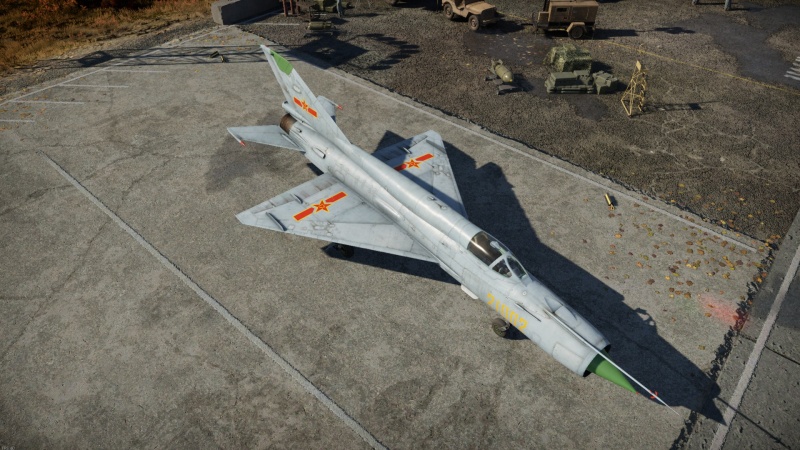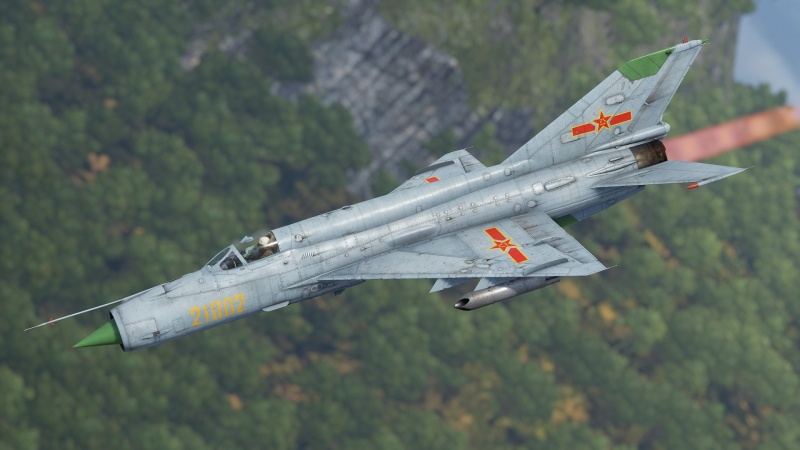Difference between revisions of "J-7D"
Colok76286 (talk | contribs) (Edits) |
Colok76286 (talk | contribs) (Added StoreImage) |
||
| Line 6: | Line 6: | ||
{{Specs-Card | {{Specs-Card | ||
|code=j_7d | |code=j_7d | ||
| − | |images={{Specs-Card-Image|GarageImage_{{PAGENAME}}.jpg}} | + | |images={{Specs-Card-Image|GarageImage_{{PAGENAME}}.jpg|StoreImage_{{PAGENAME}}_005.jpg}} |
|store=11811 | |store=11811 | ||
}} | }} | ||
Revision as of 20:16, 22 December 2022
| This page is about the Chinese jet fighter J-7D. For other MiG-21 versions, see MiG-21 (Family). |
Contents
Description
The J-7D (Chinese: 歼-7D, previously J-7IIIA; unified NATO codename: Fishcan) is a premium gift rank VII Chinese jet fighter with a battle rating of 10.7 (AB/SB) and 11.0 (RB). It was introduced in Update "Apex Predators".
The reverse-engineered version of the MiG-21MF from Egypt for all-weather operations, J-7D offers very similar performance to the late MiG-21 series with better engine and higher fuel capacity. While it lacks SARH missiles for head-on/interception missions and large-calibre rockets like S-24s, the overall combat capabilities can be still ensured by its IR AAMs and variety of Chinese ground-attack weaponries.
General info
Flight performance
Taking a look at J-7D, other than its default grey-tone camo and the PLAAF roundel onboard, the jet itself looks extremely similar to the late MiG-21 series with R-13F-300 engines. This is indeed true as J-7III series (C and D) were both based on MiG-21MFs exchanged from Egypt; in short, J-7D flies very similarly to the MiG-21MF in LSK (East German) service. The later variants of the Fishbed feature higher fuel capacity (the "spine" is filled with fuel tanks) and higher engine thrust, as well as featuring a new RP-22 radar; the J-7D exhibits all of the aforementioned upgrades. The lighter weight and higher thrust of the WP-13F1 engine also ensures a faster speed even against a MiG-21bis while having slightly better manoeuvrability as well; do remember that the J-7D is still an interceptor after all, so in most cases utilising its speed is more than enough to take out enemies at its tier. But do beware of light fighters or tailless delta-wing jets in one-on-one dogfights, it's better to quit the fight and wait for better chance to take them down in one pass.
| Characteristics | Max speed (km/h at _,___ m) |
Max altitude (metres) |
Turn time (seconds) |
Rate of climb (metres/second) |
Take-off run (metres) | |||
|---|---|---|---|---|---|---|---|---|
| AB | RB | AB | RB | AB | RB | |||
| Stock | ___ | ___ | 16000 | __._ | __._ | __._ | __._ | ___ |
| Upgraded | ___ | ___ | __._ | __._ | __._ | __._ | ||
Details
| Features | |||||
|---|---|---|---|---|---|
| Combat flaps | Take-off flaps | Landing flaps | Air brakes | Arrestor gear | Drogue chute |
| _ | _ | _ | _ | _ | _ |
| Limits | ||||||
|---|---|---|---|---|---|---|
| Wings (km/h) | Gear (km/h) | Flaps (km/h) | Max Static G | |||
| Combat | Take-off | Landing | + | - | ||
| 1365 | 700 | ___ | ___ | ___ | ~__ | ~__ |
| Optimal velocities (km/h) | |||
|---|---|---|---|
| Ailerons | Rudder | Elevators | Radiator |
| < ___ | < ___ | < ___ | N/A |
Engine performance
| Engine | Aircraft mass | |||||
|---|---|---|---|---|---|---|
| Engine name | Number | Basic mass | Wing loading (full fuel) | |||
| _____ | _ | _,___ kg | ___ kg/m2 | |||
| Engine characteristics | Mass with fuel (no weapons load) | Max Gross Weight | ||||
| Weight (each) | Type | _m fuel | __m fuel | __m fuel | ||
| ___ kg | ___ | _,___ kg | _,___ kg | _,___ kg | _,___ kg | |
| Maximum engine thrust @ 0 m (RB/SB) | Thrust to weight ratio @ 0 m (___%/WEP) | |||||
| Condition | 100% | ___%/WEP | _m fuel | __m fuel | __m fuel | MGW |
| Stationary | ___ kgf | ___ kgf | _.__ | _.__ | _.__ | _.__ |
| Optimal | ___ kgf (_ km/h) |
___ kgf (_ km/h) |
_.__ | _.__ | _.__ | _.__ |
Survivability and armour
Other than the airframe and aluminium alloy skin, the J-7D has no additional protection; any hits from enemy weapons are very likely to either severely damage the jet or take out the pilot straight away. However, an EFS system and self-sealing tanks are present onboard, giving it some chance to return to the airfield if it survives subsequent assaults from enemies.
Modifications and economy
Armaments
Offensive armament
The J-7D is armed with:
- A choice between two presets:
- 1 x 23 mm Type 23-3 cannon, belly-mounted (200 rpg)
- 1 x 23 mm Type 23-3 cannon + 72 x countermeasures
Suspended armament
| 1 | 2 | 3 | 4 | ||
|---|---|---|---|---|---|
| 250 kg 250-3 bombs | 1 | 1 | 1 | 1 | |
| 500 kg 500-3 bombs | 1 | 1 | |||
| Type 90-1 rockets | 7 | 7 | 7 | 7 | |
| Type 130-2 rockets | 4 | 4 | 4 | 4 | |
| PL-7 missiles | 1 | 1 | 1 | 1 | |
| PL-5B missiles | 1 | 1 | 1 | 1 |
To say the least, the loadout of the J-7D is very similar to its (technological) successor J-7E, as they share 5 out of the 6 loadouts. The only difference is the missiles it carries: instead of having already obsolete PL-2, it has PL-7 (reverse-engineered R.550 Magic 1 from Pakistan) players of French aircraft are very familiar with. In terms of A2A capabilities, J-7D does lack SARH missiles of any sort (R-3S, for example), but both IR-guided AAMs are among the best of their counterparts. For those who are familiar with the PL-5B's immersive thrust and overload even at distance, they can take down enemies from some distance as a safer approach to confronting masses of jets. Alternatively take PL-7 if players prefer hitting targets within 2.5 km, it might not be as powerful in higher tier where flares are abundant, it can still make short work of careless targets.
If players also decided to take on ground targets, it still has limited but sufficient options like 250/500 kg bombs and rockets of different calibre (90/130 mm). The ballistic computer also helps achieve precision hits depending on the playstyle and overall situation of the battlefield. Bring in bombs in case of columns of tanks within the blast radius, both types of bombs show enemies the importance of "social-distancing". While rockets are better for destroying SPAAs from above (since they don't have radar coverage above; given the skies are clear), for players who get used to the ballistics performance of rockets, it can still knock out even the heaviest MBTs with precision hits from 130 mm HEAT Type 90-1 rockets with overpressure.
Usage in battles
Describe the tactics of playing in the aircraft, the features of using aircraft in a team and advice on tactics. Refrain from creating a "guide" - do not impose a single point of view, but instead, give the reader food for thought. Examine the most dangerous enemies and give recommendations on fighting them. If necessary, note the specifics of the game in different modes (AB, RB, SB).
Pros and cons
Pros:
- Better engine thrust than most previous J-7/MiG-21 series thanks to the WP-13F1 engine
- Access to search radar
- Relatively better light rocket options than Soviet MiG-21MF/S series
- Devastating PL-5B or PL-7 missiles at its disposal
- Built-in countermeasures with 72 salvos, unlike its Soviet cousins
- Has full ballistic computer for cannon, rockets, and bombs; useful in ground attack
Cons:
- Bleeds energy severely during manoeuvres due to delta wing design
- Heavier than J-7E
- Poor radar performance with shorter range than common foes like F-14, F-4E
- Lacks all-aspect IR missiles and SARH missiles
- Below average pylon counts for its tier
History
By the time the Type 62 and subsequent J-7I/II series went into commission with the PLAAF in the late 1960s, the PLAAF was already seeking a new fighter for all-weather interception and to replace earlier jets in service. Although the J-8 program was also started around the same time, it was only until 1979 when J-7II was finalized and J-8I was passed for certification. This also called for a back-up for the J-8I series. During the late 1970s economy reform and increasing international arms trade with foreign countries, Chinese engineers visited countries with MiG-21MFs in service and took the design for future use; CATIC also exchanged some Soviet equipment from Egypt including MiG-23SM and MiG-21MF as the reverse-engineer subject for new interceptors.
The new J-7III started its development in March 1979 by CAC and after 5 years of repairing MiG-21MFs while building domestic prototypes, the J-7III took its first flight on 26th April 1984 and subsequent flight tests continued until 1988 when the first batches rolled off the production line. The reverse-engineered jet featured a new engine and a domestic JL-7 radar based from Type 317A radar from the failed Q-5 Yi (强-5乙, perhaps the very last torpedo bomber ever developed), but engine production issues hindered the further production of J-7III (now called J-7C under new designation) with only 17 of them built. Meanwhile, as the J-7III continued to be developed, CAC and GAIC worked on new electronics and countermeasure systems as well as a new WP-13F1 engine for the new jet. The new jet, developed in 1988, featured a new JL-7A radar capable of launching the latest PL-8 missiles, reverse-engineered Marconi Type 956 HUD, as well as Type 930-4 countermeasure system. J-7IIIA (now called J-7D) took its first flight in mid-1991 and joined the PLAAF in 1995.
Due to changes in combat doctrine, introduction of more advanced Su-27SK Flanker-B and J-7E, as well as J-8II series becoming combat-capable in 1990s and the successful development of Project No. 10 (J-10), the J-7D was deemed unnecessary and only 39 of them were built by 1999 as the placeholder for new jets; these jets made it into their first and only appearance in the National Day Parade of 1999, alongside with Flankers and air-refuel-capable J-8D.
Media
Excellent additions to the article would be video guides, screenshots from the game, and photos.
See also
External links
Paste links to sources and external resources, such as:
- topic on the official game forum;
- other literature.
| China jet aircraft | |
|---|---|
| Fighters | J-2 · J-4 · Shenyang F-5 · J-6A · J-7II · J-7D · J-7E · J-8B · J-8F · J-11 |
| Strike aircraft | Q-5 early · Q-5A · Q-5L · A-5C · JH-7A |
| Bombers | H-5 |
| American | ␗F-84G-21-RE · ␗F-84G-31-RE · ␗F-86F-30 · ␗F-86F-40 · ␗F-100A · ␗F-100F · ␗F-104A · ␗F-104G · ␗F-5A · ␗F-5E · ␗F-16A MLU |
| Soviet | ␗MiG-9 · ␗MiG-9 (l) |
| China premium aircraft | |
|---|---|
| Fighters | ␗A6M2 · D.510C · H-81A-2 · Hawk III · ␗Ki-45 hei/tei · ␗Ki-84 ko |
| Jet fighters | Shenyang F-5 · J-7D |
| Strike aircraft | A-5C · ␗F-84G-31-RE |






